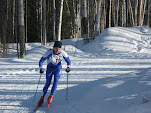Controversial Omissions for US Olympic Cross Country Ski Team
In the past (and I think this goes back into the 1970s, certainly 1984 on) they held an Olympic Trials/Winter National Championship in January and the top athletes (usually between 4 and 8 for each team) would go to the Olympics. This is very cut and dry and it's how they do it for track and field, marathoning, and swiming. The down side of this process is that you have to be on that day (and that week for skiers, because it's usually just not one race but several). Have a minor injury or illness and years of hard work go away. Another problem is that the athletes must peak twice in a short amount of time, and if they're traveling to the World Cup in December, they'd have to go back the US, re-acclimate, race hard for a week, and then gear up for the Olympics in just a few weeks.
By more or less pre-selecting the core of the team nearly a year in advance, the athletes do not have to be concerned with peaking early/twice and the travel. The downside this year was that there has little or no head to head competition between the US Ski Team that has been in Europe for the past two months and the athletes at home. The system favors established skiers at the expense of neglecting the up and comers and specialists (sprinters and long distance skiers). The youngters simply do not have enough World Cup starts to establish a points base, and specialists are constantly on the bubble because they don't have enough all around points to get a top 50 ranking.
Here is the men's point list (Super Tour rankings) for Nationals. (USST members in bold) Men’s distance
1. Hoffman
2. Freeman
3. Gregg
4. Liebsch
5. Ellefson
6. Havlick
7. Bjornsen
8. Newell
9. Koos
10. Sinnott
Men's Sprint
1. Newell
2. Hamilton
3. Koos
4. Bjornsen
5. Blackhorse-von Jess
6. Sinnott
7. Ellefson
8. Hanneman
9. Naney
10. Scott
Last week the USST went to points rankings only--no discretion nor consideration of US Nationals--and selected Bjornsen, Freeman, and Gregg, and Koos. Really. But what is really baffling is that they had 14 spots taken, and left three off the potential list of 17. Why, because they went by World Cup standings alone. So even though Hanneman got a 1st, a 2nd, and 3rd in his three races, and Ellefson won the 30K. Neither was selected.
Hannemen 152
Bjornsen 142
Freeman 120
Ellefson 116
Gregg 108
Koos 88 (only scored in the two sprint races)
Likewise, in the women's side Caitlin Gregg, Kate Fitzgerald, and Becca Rorabaugh each had a very good nationals, Gregg's win in the 20K by a whopping 3:36 seconds was a particularly strong statement. But it rings a little hollow I guess when the seven women on the USST were sequestered in Europe. We never got to see how she would have stacked up. Granted they did fly her over at the last minute, but talk about a whirlwind. Race in Soldier Hollow, hop on a plane, race a sprint (she's a distance skier) and then a 10K classic (she's a skate specialist) right away with no time to acclimate. Her bonk in the 10K classic was almost a foregone conclusion.
At the end of the day the US Nationals was nothing more than the Utah January Super Tour. There would have been no downside to adding two or three more athletes to the Olympic Team, spots that the USST has earned for doing well on the World Cup circuit in the past few years.







